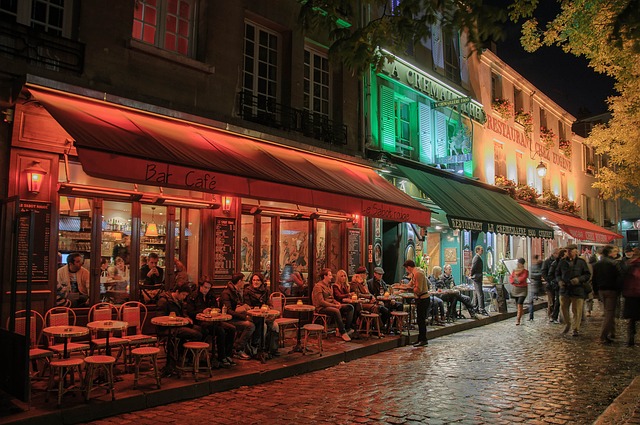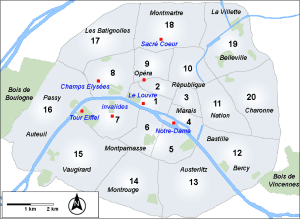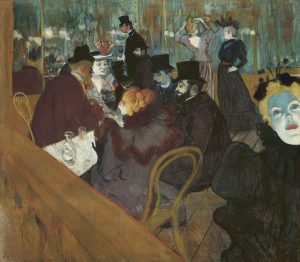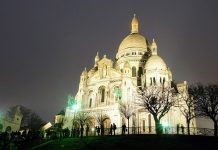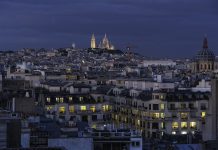Montmatre
Set on a hill 130 meters high, the area of Montmartre, part of the 18th arrondissement on the right bank, looks grandly out over all of Paris.
An historic quartier the name “Montmartre” comes from “Mont des Martyrs” (the bishop St. Denis, the priest Rustique, and the archdeacon Eleuthčre were all decapitated there around the year 250). In the 12th century, Benedictine monks built a monastery near Rue Des Abbesses. It later became the seat of a powerful abbey.
To reach the summit of La Butte Montmartre, an automatic inclined lift Le Funiculaire de Montmartre ascends from Place Saint-Pierre, running alongside the 222 steps interspersed by landings of the rue Foyatier.
 Dominating the skyline is the white-domed Basilica of the Sacré-Cœur.The Neo-Byzantine-Romanesque basilica was designed by Paul Abadie. Construction began in 1875 and continued for forty years under five different architects. The basilica, completed in 1914, was formally consecrated in 1919 after World War I.
Dominating the skyline is the white-domed Basilica of the Sacré-Cœur.The Neo-Byzantine-Romanesque basilica was designed by Paul Abadie. Construction began in 1875 and continued for forty years under five different architects. The basilica, completed in 1914, was formally consecrated in 1919 after World War I.
Sacré-Cœur Basilica has maintained a perpetual adoration of the Holy Eucharist since 1885. The site is traditionally associated with the martyrdom of Saint Denis, the patron saint of Paris.
Bars, restaurants, theatres and cabarets abound. Some, like Le Moulin Rouge and le Lapin Agile, have been made famous worldwide by the paintings of Toulouse Lautrec and Picasso. Some made famous by their illustrious performers including Yvette Guilbert, Marcelle Lender, Aristide Bruant, La Goulue, Georges Guibourg, Mistinguett, Fréhel, Jane Avril, Edith Piaf and Damia.
Known now as the Belle Epoque the years between 1871 and 1914 saw Montmartre as the center of artistic life in Paris and the model of a free, Bohemian existence. Artists,poets and writers flocked to the area attracted by low rents Towards the end of the “Golden Age” many artists moved to the Quartier Montparnasse.
The building housing the Musée de Montmartre at 12 rue Cortot is where Pierre-Auguste Renoir had a studio in 1876 and painted Bal du moulin de la Galette, depicting a Sunday afternoon dance in Montmartre, Raoul Dufy and his friend from Le Havre, Emile-Othon Friesz, shared an atelier from 1901 to 1911, and Maurice Utrillo lived from 1906 to 1914.
Picasso painted one of his most important masterpieces, Les Demoiselles d’Avignon at Le Bateau-Lavoir during 1904–1909, where many artists, including Amedeo Modigliani, Emile-Otho Friesz, lived and worked.
Other artists, poets, writers, musicians and performers associated with Montmartre include , Juan Gris , Georges Braque , Kees van Dongen , Guillaume Apollinaire , Alphonse Allais , Marcel Proust , Amedeo Modigliani , Chaïm Soutine , Pierre Bonnard , Roland Dorgelès , Max Jacob, Pierre Mac Orlan ,Dalida and Salvador Dali.
Dalida’s life is celebrated in the Place de Dalida and the works of Dali are exhibited at Dali Paris 11 Rue Poulbot.
Today around 300 officially licensed street artists, work in Montmartre, having endured a 10-year waiting list for the privilege of setting up their easel on the cobbled streets.
There are many green spaces,gardens and even a vinyard producing about 500 liters of the Clos Montmartre wine each year which can be enjoyed at Fête des Vendanges from 05 October 2023 to 09 October 2023 on the Parvis du Sacré-Coeur.
The haunting lyrics of Charles Aznavour’s 1965 international hit La Bohème recounts the passing of the youth of a 20 year old bohemian painter living in Montmartre.Performed by the chanteur français at most of his live events the song is perhaps the most emblematic of his repertoire and a classic of chanson français and chanson sur Paris.
“I’m talking to you about a time that those under twenty cannot know, In Montmartre when lilacs hung under our windows, and if the humble furnished rooms which served as our love nest, didn’t look like much, that’s where we met, me who was starving, and you who posed naked…, la bohème ,la bohème that meant, we were happy”

